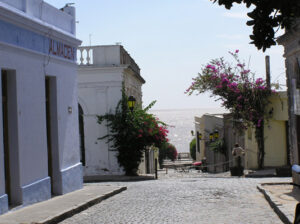

Richard Brommer
Calle de los suspiros
Many visitors agree: if you want to escape the hustle and bustle of Buenos Aires, Argentina, take the Buquebús ferry directly across the Río de la Plata, and enter another country and another world—scenic, peaceful Colonia del Sacramento. The oldest town in Uruguay and steeped in history, Colonia is best known for its barrio histórico (historic quarter), a UNESCO World Heritage site. Besides a rich and turbulent history, Colonia offers a unique charm with narrow cobblestone streets, lovely plazas, colorful colonial homes, and interesting historic landmarks.
The town was founded in 1680 by Portuguese Admiral Manuel de Lobo. The only Portuguese settlement on the Río de la Plata, Colonia quickly became the center of a continuous struggle between Portugal and Spain fighting for control of the area. In response, Spain established the settlement of Montevideo at the entrance to the Río de la Plata in 1726. For about 150 years from the time of its founding, Colonia was the focus of this bitter dispute, constantly changing hands between the Portuguese and the Spanish, until Uruguay declared its independence in 1825.
The historic quarter shows the influence of both Spanish and Portuguese styles of architecture and planning. However, the winding, disorganized cobblestone streets are clearly Portuguese as opposed to the typical Spanish gridiron design of straight streets and rectangular blocks. Does this sound like a place you would like to spend a relaxing day?
Click on the slideshow below to travel back in history as you view the charming streets and architecture of Colonia’s historic quarter.
Explore More:
1. Río de la Plata is home to the capital cities and major ports of two countries. Investigate the history and economic importance of this grand river. There is some debate as to whether the Río de la Plata is a river or an estuary. Research the difference and come to your own conclusion. Also, you might want to find out how it got its name. What does plata mean?
2. The beautiful and captivating Calle de los suspiros, leading down to the sparkling Río de la Plata, reveals a fascinating history. What does this name mean in English? Explore the different theories as to the origin of its name.
Share What You Know:
1. Read the Uruguay Newsstand article about Montevideo,which includes a segment on Montevideo’s historic district. Compare and contrast Montevideo’s Ciudad Vieja with the barrio histórico of Colonia. You may want to use a Venn diagram to organize your ideas. Then have a class discussion comparing the two districts, giving opinions about which you would prefer to visit and why. If you have visited a historic district of a city in the United States, you may want to include that in your comparison and discussion.
2. Discuss city planning and the different ways a town or city can be laid out. How is the town where you live designed? Does it seem more similar to the Portuguese or Spanish style? Is there a neighborhood in your town or in a town near where you live that reminds you of Colonia? How is it similar? Does it have a distinct ethnic flavor?